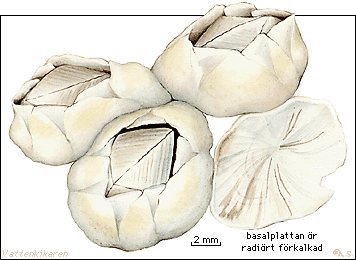|

Distribution in scandinavian waters
|
Maximum diametre: 1,7 cm.
Appearance: The chalky shell is white to grey in colour. The
opening has a slender oval or diamond form. Barnacles are usually rather
flat in form, but like other specie, can grow
vertically in height. Compare the bay barnacle with the northern
rock barnacle and the rock
barnacle.
Depth: The bay barnacle lives from close to the mean
sea-level to about 6 m deep; on rare occasions noticably deeper.
Environment: Common on boat
hulls, but can also attach itself cliffs,
rocks, algae and shells.
Misc: The curved patterns on the bottom basal plates reflect
the different directions the barnacle has taken during its growth. It
positions itself differently to allow the cirria
to position themselves against the water current.
It is believed that the bay barnacle came to these waters
from Australia during the 19th centuary.
This species tolerates low salt
concentrations and where the northern
rock barnacle cannot survive, the bay barnacle can build white bands
along cliffs and rocks. This group has characteristic
larvae.
Classification: The bay barnacle belongs to the cirripedia
group, which is a crustacean under the arthropods.
|


